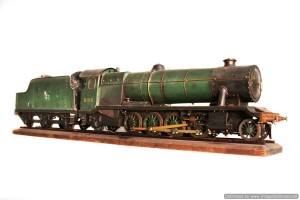Bassett Lowke/Henry Greenly
'Challenger'
This is a fascinating model locomotive and one steeped in a rich wealth of model engineering history. We are proud to be it's custodian here at The Steam Workshop. We are also very pleased to be able to add a new chapter to the Challenger story and put right some of the 'accepted' published history!
The 'Battle of the Boilers'
Most people involved in the model engineering hobby will be aware of the so called 'Battle of the Boilers' that took place in the run up to, and at the 1924 Model Engineering Exhibition. This was ultimately a contest between two miniature locomotives, one with a spirit fired boiler and one with a boiler fired upon coal to prove which was the better method.
The story had begun a couple of years earlier in the correspondence columns of the Model Engineer & Electrician Magazine (as the Model Engineer was then titled), where a number of correspondents were discussing the performance of methylated spirit fired water tube boilers in small locomotives.
Entering the debate, one Lillian (Curly) Lawrence, using the sobriquet LBSC claimed that a locomotive type boiler fired by coal was far more efficient despite being more complex to build, and was eminently practical in the smaller scales. He finished off his opening shot by suggesting that the meths fired boiler should be 'thrown in the bin',..... and the fight was on! Now having read through all these articles, we can say that in our opinion the delightfully bullish LBSC was a bit on the confrontational side in his comments, and ultimately the written debate attracted notice from such names as Henry Greenly and W.J.Bassett-Lowke, as well as other well respected pioneers of the model engineering world, which at this date was still in it's relative infancy. After a lengthy debate, and shall we say 'shots fired' on both sides,.... Bassett-Lowke who as we know owning the company bearing his name was significantly invested in the manufacture of spirit fired models at the time issued a challenge to LBSC! Smithies' boiler (meths fired) verses locomotive coal fired type.
We have reproduced all the original Model Engineer articles here in case you fancy a fascinating dip into history and reading some of the story yourselves. See who you'd have been rooting for nearly 100 years ago!
The Locomotive
Following the very public debate, W.J.Bassett Lowke, decided that it was now of paramount importance to demonstrate that a spirit fired loco was perfectly capable of hauling 'live' loads,.... (people to you and I!) He was also clearly irritated in his responses to LBSC's writings, and it seems to us that he wanted to publicly beat him as much as prove the worth of his companies products! So he asked Henry Greenly to design him a locomotive to challenge LBSC's coal fired Atlantic 'Ayesha' at the forthcoming Model Engineer Exhibition in December 1923. Greenly was by now fully occupied at the Ravenglass & Eskdale railway, and by all accounts was puzzled as to why his friend was so anxious to pursue the matter,.... himself, having given LBSC's engine and the boiler debate little further thought. However, he produced a 3 cylinder 2-8-2 design and Greenly's original drawings are re-produced below.
Bassett Lowke, allocating two of his experienced model engineers Mr. Braunston and Mr. J. Walters to the project soon had the engine under construction in their Northampton workshops. The locomotive was to be named, appropriately enough,.....'Challenger'!
Helpfully for us, Greenly also wrote up the project for the Model Engineer, and on January 10th 1924 they published a very thorough article on the project. As well as a rich description of the technical details of the model, there are a number of good photographs showing the part constructed loco which have proved invaluable to us 93 years later. Again, for your interest the article is re-produced in full here:
After the 'Head to Head' Battle
At the 1923 Model Engineering exhibition, a 60 foot length of straight, raised track was set up, and the two respective models, Ayesha and Challenger each took turns in running for 15 minutes back and fourth with their drivers in tow. Challenger completed fractionally more distance in the allocated time, (half a lap of the track, minus 10 seconds) to quote LBSC, and was therefore technically the 'winner'. Ayesha, however was pulling the 12 stone LBSC, where as the Bassett Lowke driver was only 9. Because the objectives of the whole thing were never particularly clear, and the two locos so fundamentally different, both sides were able to focus on the bits that they felt supported their objectives and claim the win. They continued to argue past each other in the subsequent press, and amusingly,.... and rather predictably, the challenge resolved nothing between the protagonists.
The full continued debate is re-produced here for you to enjoy should you feel that way inclined!
The Story post 1924!
